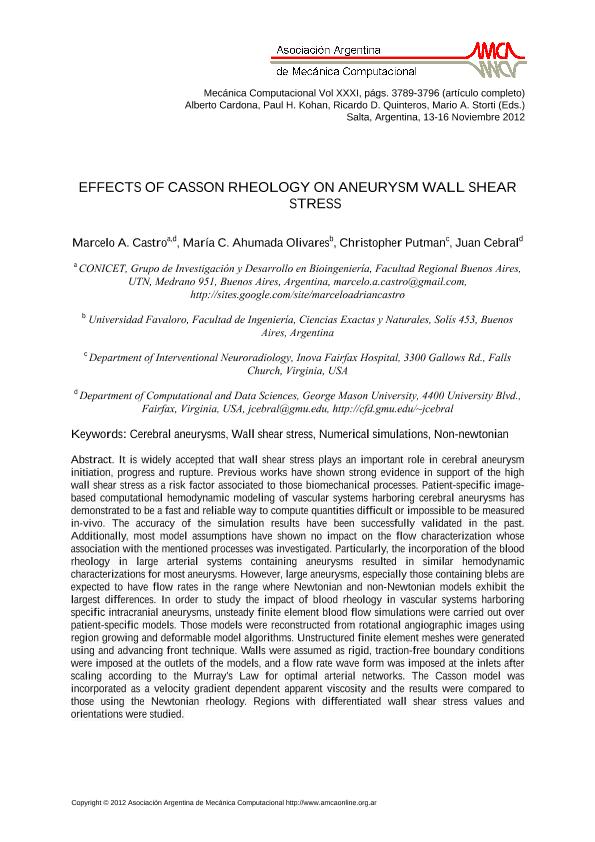Mostrar el registro sencillo del ítem
dc.contributor.author
Castro, Marcelo Adrian

dc.contributor.author
Ahumada, Maria Carolina

dc.contributor.author
Putman, Christopher M.
dc.contributor.author
Cebral, Juan Raúl
dc.date.available
2023-05-19T17:35:56Z
dc.date.issued
2012-11
dc.identifier.citation
Castro, Marcelo Adrian; Ahumada, Maria Carolina; Putman, Christopher M.; Cebral, Juan Raúl; Effects of Casson rheology on aneurysm wall shear stress; Asociación Argentina de Mecánica Computacional; Mecánica Computacional; 31; 11-2012; 3789-3796
dc.identifier.issn
1666-6070
dc.identifier.uri
http://hdl.handle.net/11336/198204
dc.description.abstract
It is widely accepted that wall shear stress plays an important role in cerebral aneurysm initiation, progress and rupture. Previous works have shown strong evidence in support of the high wall shear stress as a risk factor associated to those biomechanical processes. Patient-specific imagebased computational hemodynamic modeling of vascular systems harboring cerebral aneurysms has demonstrated to be a fast and reliable way to compute quantities difficult or impossible to be measured in-vivo. The accuracy of the simulation results have been successfully validated in the past. Additionally, most model assumptions have shown no impact on the flow characterization whose association with the mentioned processes was investigated. Particularly, the incorporation of the blood rheology in large arterial systems containing aneurysms resulted in similar hemodynamic characterizations for most aneurysms. However, large aneurysms, especially those containing blebs are expected to have flow rates in the range where Newtonian and non-Newtonian models exhibit the largest differences. In order to study the impact of blood rheology in vascular systems harboring specific intracranial aneurysms, unsteady finite element blood flow simulations were carried out over patient-specific models. Those models were reconstructed from rotational angiographic images using region growing and deformable model algorithms. Unstructured finite element meshes were generated using and advancing front technique. Walls were assumed as rigid, traction-free boundary conditions were imposed at the outlets of the models, and a flow rate wave form was imposed at the inlets after scaling according to the Murray's Law for optimal arterial networks. The Casson model was incorporated as a velocity gradient dependent apparent viscosity and the results were compared to those using the Newtonian rheology. Regions with differentiated wall shear stress values and orientations were studied.
dc.format
application/pdf
dc.language.iso
eng
dc.publisher
Asociación Argentina de Mecánica Computacional
dc.rights
info:eu-repo/semantics/openAccess
dc.rights.uri
https://creativecommons.org/licenses/by-nc-sa/2.5/ar/
dc.subject
Cerebral aneurysms
dc.subject
Wall shear stress
dc.subject
Numerical simulations
dc.subject
Non-Newtonian
dc.subject.classification
Otras Ingenierías y Tecnologías

dc.subject.classification
Otras Ingenierías y Tecnologías

dc.subject.classification
INGENIERÍAS Y TECNOLOGÍAS

dc.title
Effects of Casson rheology on aneurysm wall shear stress
dc.type
info:eu-repo/semantics/article
dc.type
info:ar-repo/semantics/artículo
dc.type
info:eu-repo/semantics/publishedVersion
dc.date.updated
2023-05-18T13:15:17Z
dc.journal.volume
31
dc.journal.pagination
3789-3796
dc.journal.pais
Argentina

dc.journal.ciudad
Santa Fe
dc.description.fil
Fil: Castro, Marcelo Adrian. Universidad Tecnológica Nacional. Secretaria de Ciencia y Técnica; Argentina. Consejo Nacional de Investigaciones Científicas y Técnicas; Argentina
dc.description.fil
Fil: Ahumada, Maria Carolina. Universidad Favaloro. Facultad de Ingeniería y Ciencias Exactas y Naturales; Argentina
dc.description.fil
Fil: Putman, Christopher M.. Innova Fairfax Hospital; Estados Unidos
dc.description.fil
Fil: Cebral, Juan Raúl. George Mason University; Estados Unidos
dc.journal.title
Mecánica Computacional
dc.relation.alternativeid
info:eu-repo/semantics/altIdentifier/url/http://www.cimec.org.ar/ojs/index.php/mc/article/viewFile/4296/4222
dc.relation.alternativeid
info:eu-repo/semantics/altIdentifier/url/https://cimec.org.ar/ojs/index.php/mc/article/view/4296
Archivos asociados
